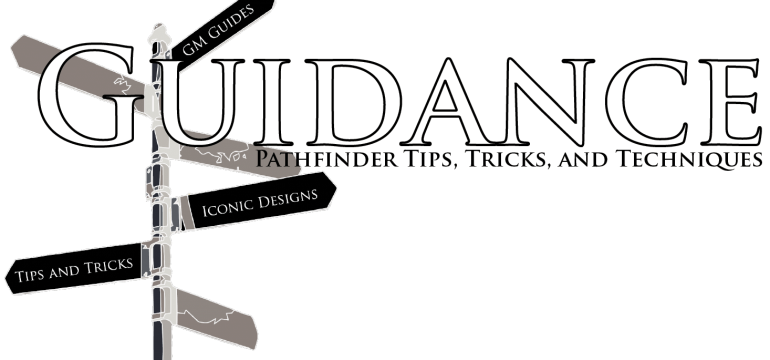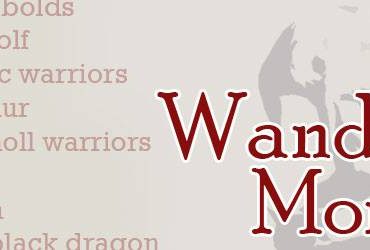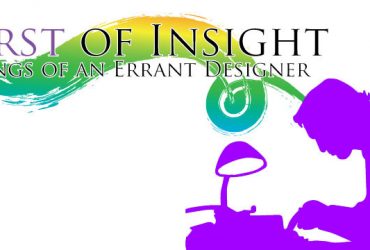Welcome back to Part 2 of an indefinitely-numbered series on being a freelancer! Last time, I very generally went over marketability as a Pathfinder RPG freelancer, and touched on the three important qualities that you need to be a successful freelancer: innovativeness, timeliness, standardization, and lawfulness. Now, you might have thought that last week I organized them from most important (innovativeness) to least important (lawfulness). Well, you’d be incorrect. Sort of.
You see, innovativeness, the generation of good ideas, is what will get you hired once. But innovativeness will NOT get you hired multiple times if you are not timely, standardized, or lawful. And if you get one gig and never freelance again, guess what? You were never a freelancer to begin with. To be a freelancer is to get multiple assignments and continuous work. And frankly, innovativeness is the EASIEST of the four quality to get. Good ideas are cheap. Being able to write those ideas down effectively is skill, and that is governed by your timeliness, standardization, and lawfulness.
So today, just to be spiteful, I am going to talk about lawfulness. So buckle up all of you self-described chaotic neutrals—we’re about to get axiomatic.
The Laws of the Land
Lawfulness, as it applies to freelancers, is the ability to fall the rules of freelancing. And believe me, there are rules. Your publisher, be it Paizo or Everyman Gaming LLC, will have rules and regulations for you to follow. They’ll have specific forms they want you to follow, templates to use, design paradigms, the works. Even if they’re all, “Do whatever is awesome!” that’s still a rule that you need to follow, albeit an easy one.
However, there are two crucial rules that all PUBLISHERS need to follow when it comes to producing content, and if you as a freelancer are familiar enough with those rules that you make your publisher’s life easier, then guess what? You’re going to get hired again. Now, the two most basic rules, in order of importance, are the Open Gaming License (“OGL”) and the Pathfinder Compatibility License (“PCL”). These rules serve an INCREDIBLY different purpose, so you’ll need to follow me on their differences. I firmly believe that a rule is difficult to follow if you don’t know the origin, so we’re going to take a minute to talk about them. Let’s Go!
OGL, the Reason for the Season
The OGL is arguably the most important piece of legal information for any Third-Party Publisher, Paizo Inc itself included. The OGL was originally created WAY back by Wizards of the Coast in 2000. Ryan Dancey, the “Father of Open Gaming” spearheaded the OGL’s creation, which would allow individuals, amateur companies, and professional companies and groups to publish works derived from the 3.5 Edition of D&D under a format called the “Systems Reference Document,” (“SRD”) under the d20 System Trademark. This move was HUGE. It ushered in the open gaming movement, which basically allowed Third-Party publishers to reference select Dungeons and Dragons copyrighted trademarks, rules, and mechanics. Without the creation of the SRD and OGL, Pathfinder would not exist, as mechanical concepts like feats, the Vancian spellcasting system, or even common lingo like the “d20” couldn’t be used, nor could classic D&D concepts like the tarrasque. I will reiterate—the OGL represents generosity that is simply unseen in the business sector, and our “industry” largely exists in the capacity it does today because of the OGL. If you are a 3PPublisher or freelancer, you absolutely owe every dollar you’ve ever made writing or selling 3PP to the OGL, so it is crucial for you to know what the OGL is and how to comply with it.
So the first thing I’m going to do is provide you with the mandated OGL that you can get from Wizards of the Coast’s open gaming foundation site: http://www.opengamingfoundation.org/ogl.html
Second, here’s the OGL link that the Pathfinder Reference Document (the PRD) uses: http://paizo.com/pathfinderRPG/prd/openGameLicense.html
So you’ll probably notice a few things about the OGL—first, points 1 through 14 look the same in both documents. Second, Point 15 is MUCH larger in the PRD’s than in Wizard’s. That’s because whenever you reference copyrighted material, you need to include that material’s OGL copyright, plus ALL copyrights that the material uses.
For instance, let’s say you wanted to reference the Pathfinder Roleplaying Game Core Rulebook. You would first need a copy of the OGL as it appears on Wizards of the Coast’s site—this is basically the “core agreement,” so to speak. Next, you would need the OGL copyright of the Pathfinder RPG Core Rulebook—you can find that in the back of the CRB, under its OGL declaration. Third and finally, you would need to include a copy of EVERY OGL declaration in the CRB that isn’t already on your license in your product’s OGL. (This means you don’t need to cite the Open Game License twice, but you would need a copy of the SRD, the Book of Experimental Might, and the Tome of Horrors.
This requirement of the OGL to include copyrights of every product referenced in your book is what makes many 3PP OGLs so long—EVERYTHING you use must be legally cited. It doesn’t even matter if you reference a product’s name in your text—if any part of that product appears in your product, you need its copyright information in your OGL’s section 15.
As a result, effective freelancers ONLY use OGL products in their work (aka its from a product with the Open Gaming License somewhere in the text), and they ALWAYS give a list of those products to their publishers. Freelancers who want to REALLY impress their 3PP will compile the Section 15s of all products they use and hand that over with their turnover, preferably in alphabetical order. (Note that Paizo will never make you do that.)
Now, this is enough information to bring us to the SECOND important legal document—the Pathfinder Compatibility License
PCL, the Heir to 3.5
Okay, so the first thing that you need to know is that the OGL only covers game mechanics. Things that could be considered stories, storylines, plots, thematic elements, dialogue, incidents, language, artwork, symbols, designs, depictions likenesses, formats, poses, concepts, themes, and any artistic rendition of a product’s likeness or trade dress is NOT covered under the OGL. This means that the idea of “goblins” as “small, green, big heads, long ears, and lovers of fire?” TECHNICALLY that isn’t covered under the OGL, as that would fall under the “depictions” clause of the OGL.
And that’s not the only thing! TECHNICALLY every product Paizo has ever published would be considered “language” and “trade dress.” As would the name of the game, the “Pathfinder Roleplaying Game.” TECHNICALLY you can’t cite ANYTHING with the word Pathfinder.
That is, you can’t. Without the Pathfinder Compatibility License.
The OGL has a clause under Section 1 that notes if you want to use any of those elements I listed above, you need to enter a separate agreement with the IP holder (in this case, Paizo). That “separate agreement” is known as the Pathfinder Compatibility License. (For Starfinder, it’s called the Starfinder Compatibility License.) You can read the PCL here: http://paizo.com/pathfinderRPG/compatibility .
So, the PCL has a bunch of sections too, and they basically spell out what you can and cannot use. If you sign the PCL agreement, you basically have to honor all of Paizo’s trademarks, adhere to all of their rules, and refrain from using the license in a way that suggests that your product is a Paizo product or is directly endorsed by Paizo. This means you can’t make your product LOOK like a Paizo product via font or background or whatnot, you can’t include trademarked terms (this includes Pathfinder or Pathfinder Roleplaying Game). The license is also notes what happens if you breach it, notes that the license is not compatible with any product that could be considered “adult” or “inappropriate for minors,” and Paizo can terminate the license whenever they want. There’s also a whole bunch of disclaimers you have to include on the title page of your product, and you get a PCL logo you have to put on the front and back of your product.
It sounds harsh, but it is REALLY generous. Specifically, this agreement allows you to reference and cite specific Paizo products.
If you scroll down to the end of the PCL to Exhibit B, you’ll see a list of products that you’re allowed to reference in your OGL product. It is basically every Core Rulebook product, plus the Bonus Bestiary. Section 5 also describes how referencing works works in products—there’s actually a very specific format you’re supposed to follow that can be altered slightly, but not much. Its basically section, then chapter, than book.
The big takeaways from this for freelancers is Exhibit B. That is the list of products that you are allowed to directly call out by name and/or reference in a 3PP. If a product isn’t listed there, YOU CANNOT REFERENCE IT. You can republish everything you want under the OGL and include the product you took the text from in your Section 15, but you CANNOT reference the product that the content comes from by name.
For instance, let’s say you LOVED the kitsune rules I wrote in Blood of the Beast, and you wanted to sell me a product that built on them, and you included a rules element that referenced Blood of the Beast in the following manner: “see the kitsune section in Pathfinder Player Companion: Blood of the Beast.” That, technically, is a legal wordage for a reference as per Section 5, but the reference itself is illegal because Pathfinder Player Companion: Blood of the Beast does not appear on Exhibit B of the PCL. If you wanted to use something from Blood of the Beast, you would have to lift the content whole cloth and note that to me, so I could put Blood of the Beast’s copyright info into my product’s Section 15.
THIS IS ENTIRELY LEGAL, and its thanks to the OGL. Blood of the Beast may not be part of the PCL agreement, but it was published under the OGL, and therefore anything that isn’t IP is fair game.
Summary
To sum this up, here are some takeaway points:
- The OGL lets you use game mechanics from other OGL products. You need to include a copy of the OGL in everything you write for Pathfinder, and list ALL OGL products that you reference in your product’s Section 15.
- The PCL lets you reference select Paizo products in the body of your products. It counts as a “separate agreement” as defined by the OGL, and works hand-in-hand with that product. The PCL has additional requirements and restrictions imposed by Paizo itself, but the ability to cite Paizo’s work makes it ultimately worth the small hassle it provides.
Next time, I’ll be talking about standardization, which revolves around taking these laws and legal precedents and using them to properly cite and reference your products, as well as “write good.” So until next time, I’m Alex Augunas and I’m always here for YOU when you need a little bit of Guidance. Take care!
Alexander “Alex” Augunas has been playing roleplaying games since 2007, which isn’t nearly as long as 90% of his colleagues. Alexander is an active freelancer for the Pathfinder Roleplaying Game and is best known as the author of the Pact Magic Unbound series by Radiance House. Alex is the owner of Everyman Gaming, LLC and is often stylized as the Everyman Gamer in honor of Guidance’s original home. Alex also cohosts the Private Sanctuary Podcast, along with fellow blogger Anthony Li, and you can follow their exploits on Facebook in the 3.5 Private Sanctuary Group, or on Alex’s Twitter, @AlJAug.






